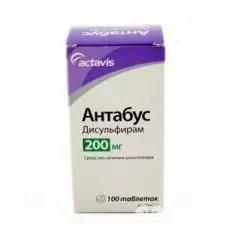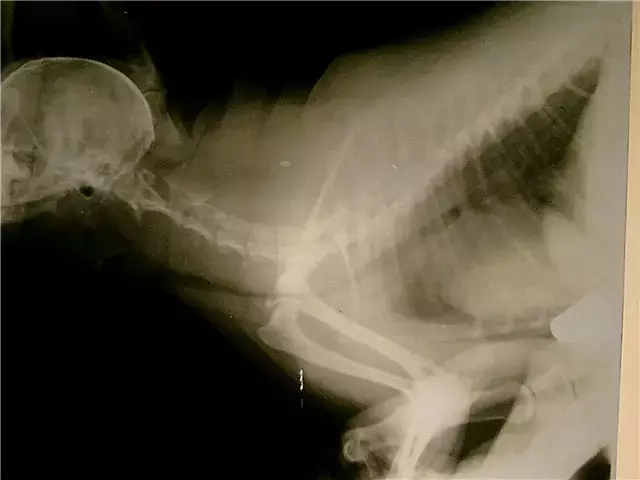- Author Rachel Wainwright [email protected].
- Public 2023-12-15 07:39.
- Last modified 2025-11-02 20:14.
Antabuse
Instructions for use:
- 1. Release form and composition
- 2. Indications for use
- 3. Contraindications
- 4. Method of application and dosage
- 5. Side effects
- 6. Special instructions
- 7. Drug interactions
- 8. Analogs
- 9. Terms and conditions of storage
- 10. Terms of dispensing from pharmacies

Antabuse is a drug that, in combination with ethyl alcohol, causes the following negative effects: nausea, vomiting, flushing, tachycardia, hypotension, etc.; drinking alcohol after taking it is extremely unpleasant, which forms a conditioned reflex aversion to the smell and taste of alcoholic beverages.
Release form and composition
Dosage form Antabus - effervescent tablets: almost white or white, round, flat, with beveled edges:
- dose 0.2 g: one side is separated by a line with markings on the sides "CD" | "C" (100 pcs. In high density polyethylene containers / dark glass vials with a polyethylene cap, 1 container / bottle in a cardboard box);
- dose of 0.4 g: on one side there is a cross-shaped line dividing the tablet into four equal parts, and the marking "CJ" (50 pcs. in HDPE containers / dark glass vials with a polyethylene lid, 1 container / bottle in a cardboard pack).
1 effervescent tablet contains:
- active substance: disulfiram - 0.2 g or 0.4 g;
- auxiliary components: povidone, corn starch, tartaric acid, talc, magnesium stearate, sodium bicarbonate, colloidal silicon dioxide, microcrystalline cellulose.
Indications for use
The drug is indicated for the treatment and prevention of recurrence of chronic alcoholism.
Contraindications
Absolute:
- severe pathologies of the cardiovascular system, including uncompensated heart failure and coronary circulation disorders such as arterial hypertension, ischemic heart disease;
- severe organic brain damage, history of stroke;
- severe renal failure;
- neuropsychiatric disorders, including psychoses, risks of suicidal attempts, severe forms of pathologies related to personality disorder;
- severe liver dysfunction with exceeding the upper limit of the normal activity of microsomal hepatic enzymes by 3 times or more, information in the history of adverse reactions from the liver during previous therapy with disulfiram;
- alcohol intoxication or the use of ethanol-containing drugs or drinks within 24 hours before taking the drug;
- drug dependence syndrome;
- the period of pregnancy and lactation (there is insufficient data on the safety and efficacy of using Antabus in this category of patients);
- children and adolescents under 18 years of age (there are no data on the safety and effectiveness of use);
- hypersensitivity to disulfiram or auxiliary components of the drug.
Relative: Antabuse is used with caution in diabetes mellitus, hypothyroidism, signs of irreversible brain damage, renal failure, diseases of the respiratory system or liver, epilepsy or convulsive syndrome of any origin (increased likelihood of disulfiram-ethanol reaction in a more severe degree), peripheral neuropathy, peptic ulcer diseases of the stomach and duodenum 12, optic neuritis, as well as in old age (after 60 years).
Method of administration and dosage
Antabuse effervescent tablet taken orally after dissolving in water (1 / 2 cups).
The drug is used only under medical supervision. Therapy is prescribed after a thorough clinical examination of the patient and a warning about abstinence from alcohol during treatment, as well as possible complications and consequences.
The drug is taken according to an individual scheme, determined by the attending physician, at the rate of 0.2-0.5 g 1-2 times a day.
After 7-10 days from the start of therapy, it is necessary to conduct a disulfiram-alcohol test. To do this, the patient is given 20-30 ml of vodka after taking 0.5 g of the drug, if the reaction is weak, the dose of alcohol is increased to 30-50 ml (the maximum allowable dose of vodka is 100-120 ml). After 1-2 days, the test is repeated in a hospital, after 3-5 days - on an outpatient basis, if necessary, adjust the dose of alcohol and / or the drug. In the future, Antabuse is allowed to be used in a maintenance dose of 0.15-0.2 g / day for 1-3 years.
Side effects
Nonspecific side effects most often observed when taking Antabus, which, inter alia, may be associated with the underlying disease: headache, drowsiness, reactions from the gastrointestinal tract (GIT). If they appear, it may be necessary to reduce the dose of the drug.
The frequency of unwanted reactions from organs and systems (in accordance with the following classification -> 1/10 - very often,> 1 / 100-1 / 1000-1 / 10,000 - <1/1000 - rarely, <1/10 000, including isolated cases - very rare, the frequency is unknown):
- Gastrointestinal tract: often - epigastric pain, nausea, vomiting, diarrhea, metallic taste in the mouth, bad breath; frequency unknown - unpleasant odor in colostomy patients due to carbon sulfide;
- hepatobiliary system: often - increased activity of hepatic enzymes (gamma-glutamyltransferase and transaminases); rarely, jaundice; very rarely - clinical symptoms of hepatotoxicity, liver cell damage, hepatitis, fulminant hepatitis due to extensive liver necrosis, which can result in liver failure, hepatic coma and death (these side effects usually occur during the first 8 weeks of therapy and are not dose-dependent);
- immune system: infrequently - allergic reactions;
- data from laboratory and instrumental studies: rarely - deviations of the results of liver function tests from normal values, including an increase in the concentration of bilirubin in the blood and an increase in the activity of aspartate aminotransferase (AST) and alanine aminotransferase (ALT);
- nervous system: often - taste perversion, drowsiness, headache; rarely - polyneuropathy, peripheral neuropathy, optic neuritis (smokers are most prone to its development), tremor, encephalopathy; very rarely - confusion, convulsions, neurological disorders (most likely dose-dependent, usually occur several months after the start of treatment, are slowly reversible);
- psyche: often - mania, depression; rarely - psychotic reactions (schizophrenia, paranoia) (such disorders occur mainly in patients with schizophrenia or depression in history, they are probably associated with an increase in dopamine levels as a result of inhibition of dopamine-β-hydroxylase by disulfiram); very rarely - acute organic brain syndrome, behavior disorders;
- genitals and mammary gland: infrequently - sexual dysfunction, decreased libido;
- skin and subcutaneous tissue: infrequently - allergic dermatitis, acne, pruritus, rash;
- other reactions: often - a subjective feeling of discomfort, drowsiness, fatigue.
Adverse reactions likely resulting from the combined use of disulfiram and ethanol:
- cardiovascular system: palpitations, tachycardia, shortness of breath, arrhythmias, dizziness, fainting;
- Gastrointestinal tract: vomiting;
- musculoskeletal system: muscle spasm;
- nervous system: headache, drowsiness, lack of coordination, loss of consciousness;
- psyche: apathy;
- skin and subcutaneous tissue: hyperhidrosis, flushing of the face;
- vessels: hypotension, cardiovascular collapse;
- other reactions: fatigue.
The result of an overdose of a combination of ethanol-disulfiram may be cardiovascular collapse, depression of consciousness (up to coma), neurological complications. In such a situation, symptomatic therapy is carried out.
special instructions
Patients need to be warned about the dangers of a reaction intolerance to alcoholic beverages.
With the simultaneous appointment of Antabus with oral anticoagulants, more frequent monitoring of the prothrombin content and correction of anticoagulant doses is necessary, this is associated with an increased likelihood of bleeding.
Patients with hypothyroidism or renal failure take disulfiram with caution, especially at the risk of its possible combination with alcohol.
Adverse reactions caused by taking disulfiram (including fatigue and drowsiness) affect the speed of psychomotor reactions and the ability to concentrate. In the event of the appearance of such conditions during the period of therapy with Antabus, it is required to refrain from controlling complex mechanisms and vehicles, including a car.
Drug interactions
Ascorbic acid reduces the reaction of disulfiram to ethanol.
The combined use of Antabus and alcohol (alcoholic beverages and medicines containing alcohol) is contraindicated, since this can cause intolerance reactions accompanied by flushing, erythema, vomiting, tachycardia.
Other undesirable and cautionary combinations with disulfiram:
- isoniazid - a possible violation of coordination and behavior;
- ornidazole, secnidazole, metronidazole, tinidazole (nitro-5-imidazoles) - can cause confusion and delirious disorders;
- phenytoin - disulfiram suppresses its metabolism, as a result of which there is a rapid and significant rise in the level of phenytoin in plasma, accompanied by toxic symptoms;
- oral anticoagulants (including warfarin) - their effect and the risk of bleeding increase as a result of a decrease in decay in the liver (more frequent monitoring of the concentration and dose adjustment of anticoagulants is required, including within 8 days after disulfiram is discontinued);
- theophylline - its dose must be adjusted downward, depending on the plasma concentration and clinical symptoms (due to inhibition of theophylline metabolism by disulfiram);
- benzodiazepines - Antabuse is able to potentiate their sedative effect by inhibiting oxidative metabolism (especially diazepam and chlordiazepoxide), which requires dosage adjustment in accordance with the clinical picture;
- tricyclic antidepressants - there is a possibility of an increased ethanol intolerance reaction, especially in patients taking alcohol while on disulfiram therapy.
When the above combinations cannot be avoided, during therapy and after treatment with Antabuse, it is necessary to control plasma concentrations of the drug and regular clinical observation of patients.
Analogs
Antabus analogs are: Esperal, Livedin, Teturam.
Terms and conditions of storage
Store at a temperature not exceeding 30 ° C. Keep out of the reach of children.
The shelf life is 5 years.
Terms of dispensing from pharmacies
Dispensed by prescription.
Information about the drug is generalized, provided for informational purposes only and does not replace the official instructions. Self-medication is hazardous to health!






